Psychology
Service for smiles
Given an equal choice, will a store clerk first serve a smiling or a frowning customer?Science provides the answer. Clerks go toward the smiler.
Maybe this is why it's so hard to ever get help in Home Depot. I need to be grinning more.
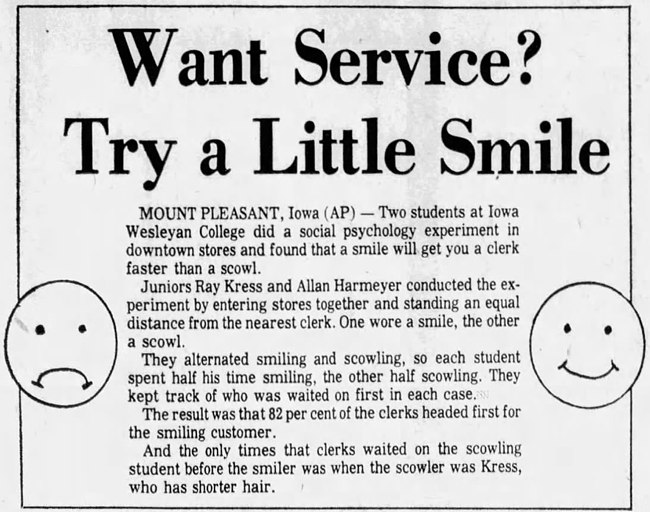
Elmira Star Gazette - Dec 11, 1972
Posted By: Alex - Thu Nov 30, 2017 -
Comments (3)
Category: Science, Psychology, Shopping
Bikini Experiment
So why was Simone Harris standing on a Sydney street in a bikini? Was this a publicity stunt? Was she a psychologist conducting research? A performance artist being weird? I haven't been able to find answers anywhere.
Racine Journal Times - June 17, 1970
Posted By: Alex - Wed Nov 15, 2017 -
Comments (2)
Category: Experiments, Psychology, 1970s
Air Raid Noise Experiment
These pictures in the Google Arts picture archive don't come with any explanatory text, except that they're from an "Air Raid Noise Experiment" conducted in Nuneaton in 1941. But I suspect that the experiment was part of a series of psychological experiments conducted in the UK in 1941 that attempted to "harden Britons to bomb shock." The idea was to expose people to the sounds of air raid sirens and battle sounds so that they would lose their fear of them. As described in the news clipping below: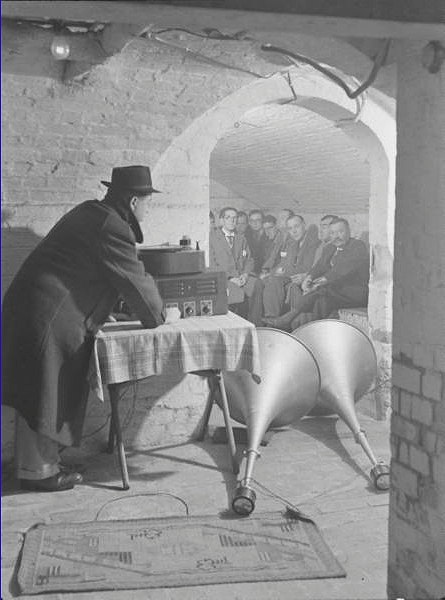


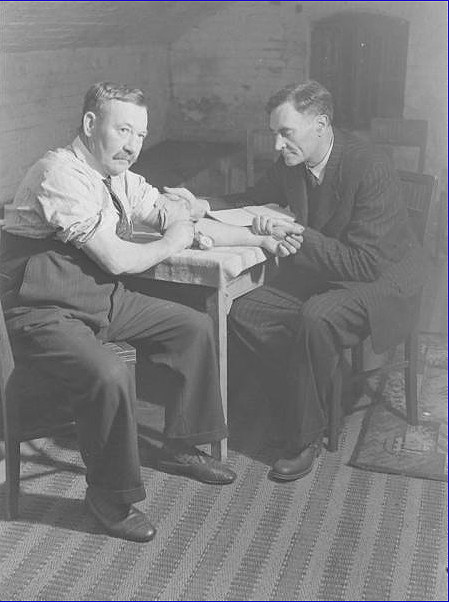

The Greenfield Daily Reporter - Nov 28 1941
I've been aware of these experiments for a while. I previously posted something about them back in 2009. But I just came across these photos and realized they must be from one of these experiments.
Posted By: Alex - Thu Nov 02, 2017 -
Comments (2)
Category: Noises and Other Public Disturbances of the Peace, War, Experiments, Psychology, 1940s
Naked Chicken Research
1976: Drs. William Johnson and Robert Truax of Louisiana State University raised and studied featherless chickens."I guess 'embarrassed' is as good a word for it as any. You put one of them in with a flock of normal birds, and it huddles off in a corner by itself. The other birds won't have anything to do with it until they get used to it," he said.
"And then they're just not as active sexually. They will court and strut much more than the normal bird, but they don't mate as readily."
The story reminds me of the old urban legend about KFC raising mutant, featherless chickens. Maybe this is where the story started.

Argus Leader - Aug 31, 1976

Salisbury Daily Times - Aug 31, 1976
Posted By: Alex - Fri Sep 29, 2017 -
Comments (4)
Category: Animals, Science, Psychology, 1970s
Conditioning experiment on Soviet child
I ran across these intriguing images in an old copy of Newsweek - March 28, 1960.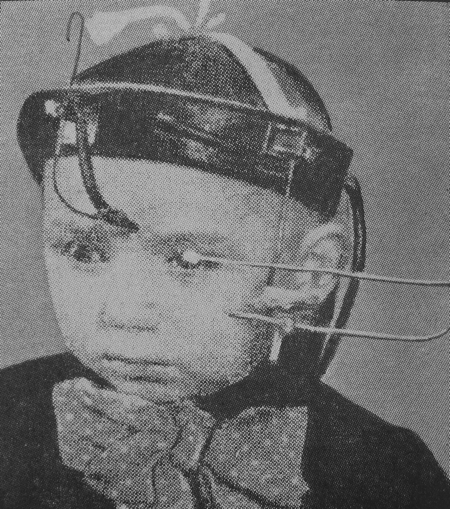
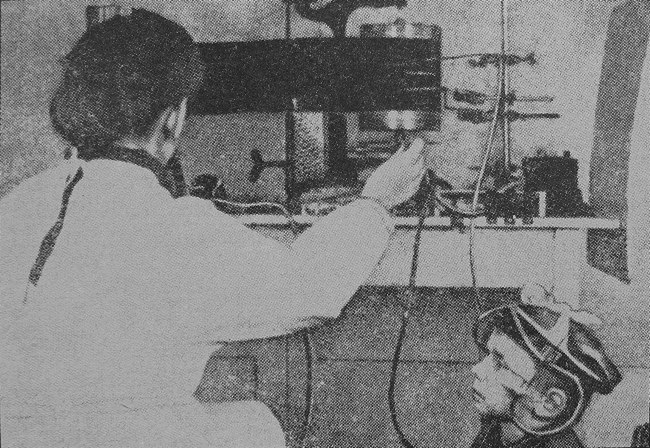
Unfortunately there wasn't much explanation about them. The caption read: "Psychological sputnik: Year-old Soviet child rigged for conditioning experiment."
An accompanying article, about the visit of Soviet psychologist Alexander R. Luria to the U.S., didn't refer to the images at all. But offered this hint:
Luria's own goal and the goal of Soviet psychopedagogy, is important, too: Increasing the learning ability of Soviet children by 25 per cent.
"Think of it," he said, "such a finding would be worth billions of dollars. It is no less important than a sputnik."
So the images must be showing some kind of weird Soviet experiment to boost a child's IQ.
The kid would be too young to be Putin. Though there is a slight resemblance.
Posted By: Alex - Thu Jul 27, 2017 -
Comments (3)
Category: Psychology, 1960s
The Bowery-el Phenomenon
Psychologists have found that a person can easily become habituated to a repeated stimulus. But if the stimulus is removed, its absence can itself be perceived as a kind of phantom stimulus. This is known as the "Bowery-el phenomenon" — named after the Bowery el (or Third Avenue el), the elevated rail line that used to run through New York City. The cognitive scientist Karl Pribram explained the term in a Jan 1969 Scientific American article, "The Neurophysiology of Remembering":And there's a slightly fuller description at indiana.edu:
The indiana.edu article says the flurry of calls occurred in the 1960s, but I think they must be mistaken, since the Bowery el was torn down in 1955.

The Bowery el, aka Third Avenue el. Image via wikipedia
Posted By: Alex - Sat Jun 03, 2017 -
Comments (2)
Category: Psychology
Destruct Therapy
The Stop Stress Group is a Spanish company founded by Jorge Arribas Haro in 2003. It offers stress management and team-building therapy to companies, and it specializes in "Destruct Therapy" (Destructoterapia), which involves giving office workers sledge hammers, taking them out to a junk yard, and having them vent their rage on "cars, washing machines, refrigerators, television sets, and so on."In the video below there's one burly guy who seems like a ringer, and then a bunch of people who are more like tapping the car with the sledgehammer. They're probably thinking, "Why do we have to do this idiotic team building exercise?"
The concept of Destruct Therapy reminds me of Destructivist Art.

Posted By: Alex - Thu May 04, 2017 -
Comments (5)
Category: Business, Psychology
How many ways are children annoying?
Back in 1931, Dr. Mandel Sherman, director of the Child Research Centre, wanted to find out the exact number of ways in which children annoy their parents. He came up with the oddly specific number of 2,124 different ways.He arrived at this number by having a group of parents carry notebooks around with them for a week and record each time their child annoyed them.
Some of the ways in which the children annoyed: being disobedient, being too slow or too quick, not being neat, primping, etc.
Personally, I think he seriously lowballed that number.
We've encountered the work of Dr. Sherman before. Back in 2009, I posted about his advice that instead of training kids to be successful in life, we should train them to accept the inevitability of failure. That way, they'll be much happier when they actually do end up as mediocre flops.

The New York Times - Jan 30, 1931
Posted By: Alex - Mon Mar 20, 2017 -
Comments (3)
Category: Psychology, Children, Parents, 1930s
Brake Reaction Time
In the mid 1930s, Dr. Harry DeSilva of the Massachusetts State College at Amherst created a brake reaction test to measure how quickly drivers can step on the brake in response to a red light. He took it around the country and tested thousands of people.People in their mid 20s generally had the quickest reaction times, and then times declined with age, which wasn't a surprise. Slightly more surprising was that short people generally had faster responses than tall people. From Time magazine (Aug 1935):
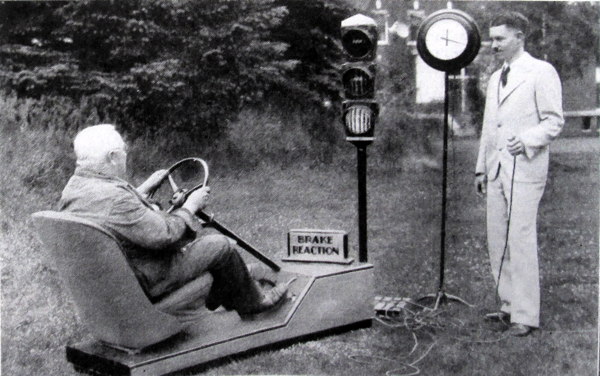
Time - Aug 26, 1935
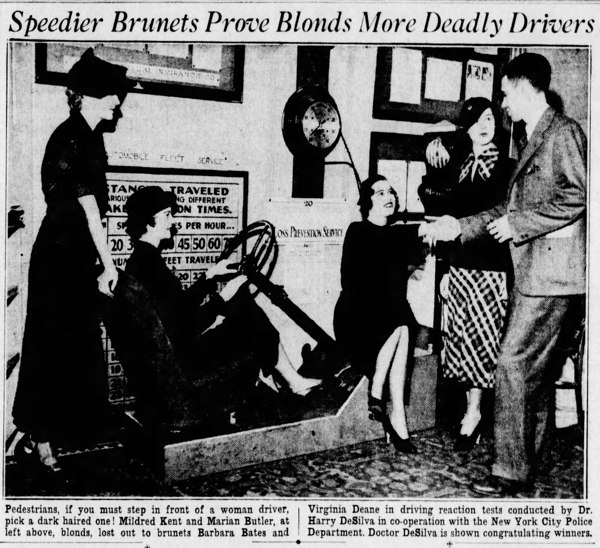
Democrat and Chronicle - Mar 15, 1936
Posted By: Alex - Fri Mar 17, 2017 -
Comments (4)
Category: Motor Vehicles, Cars, Psychology, 1930s
Miniature Driving School
Back in the 1930s, if a Detroit judge suspected a driver was mentally unfit to be on the road, he might send the driver to see Dr. Lowell Selling, who would test the driver using a miniature street intersection to simulate various situations. However, I'm not sure what exactly this testing involved, beyond that vague description.I found a brief note about Dr. Selling in the Law Enforcement Executive Forum (2008, pdf, p.51):
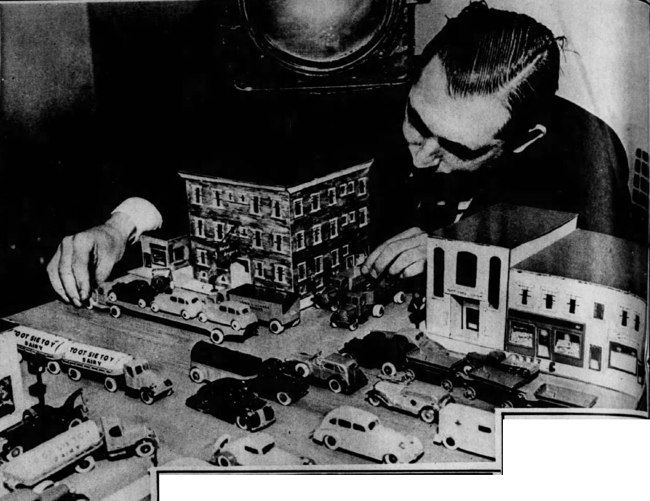
St. Louis Post-Dispatch - Sep 13, 1936
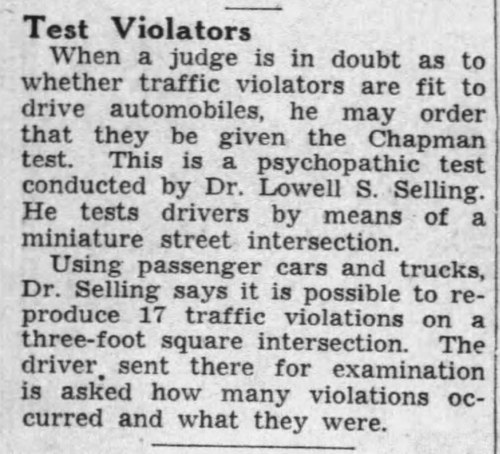
Palladium-Item - Oct 21, 1936
Posted By: Alex - Thu Jan 19, 2017 -
Comments (2)
Category: Motor Vehicles, Psychology, 1930s

| Who We Are |
|---|
| Alex Boese Alex is the creator and curator of the Museum of Hoaxes. He's also the author of various weird, non-fiction, science-themed books such as Elephants on Acid and Psychedelic Apes. Paul Di Filippo Paul has been paid to put weird ideas into fictional form for over thirty years, in his career as a noted science fiction writer. He has recently begun blogging on many curious topics with three fellow writers at The Inferior 4+1. Contact Us |




